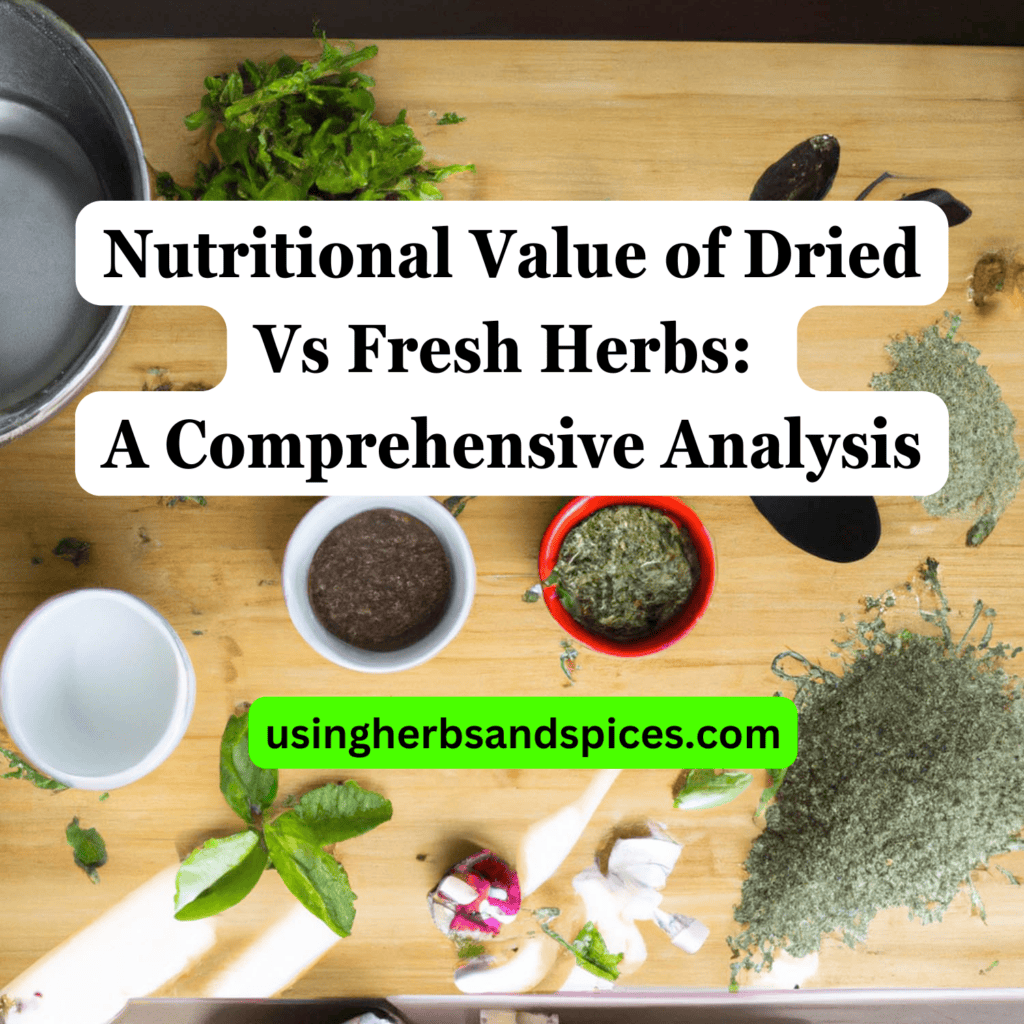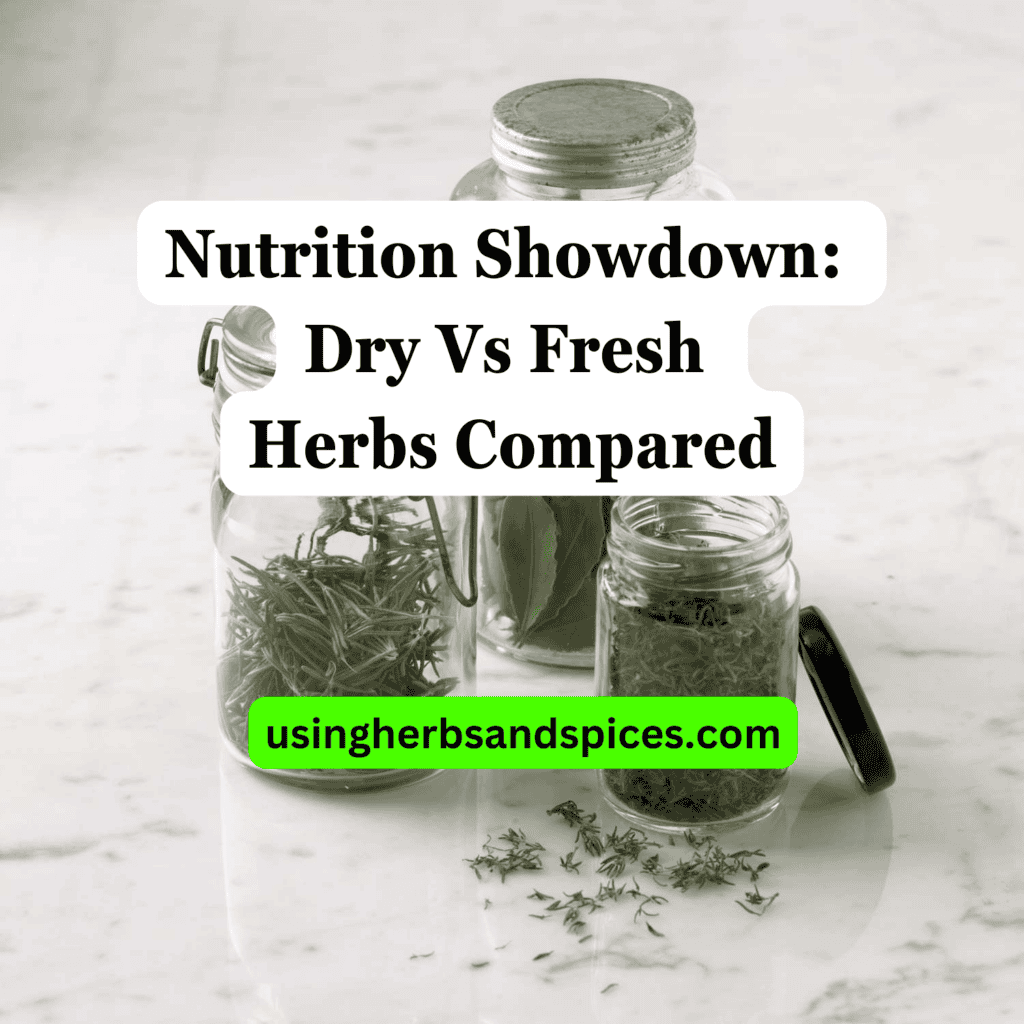SUMMARY: The drying process of herbs can lead to a potential loss of certain nutrients, resulting in varying nutritional values between fresh and dried herbs. In the comparison of their contents, it’s seen that while dried herbs tend to be more concentrated sources of nutrients, fresh herbs maintain higher levels of certain vitamins, thereby offering varying but equally valuable contributions to a healthy diet.
Have you ever wondered about the nutritional differences between dried and fresh herbs?

The quest to optimise every ingredient’s nutritional value in your diet can be an intriguing journey.
- Understanding dried versus fresh herbs
- The potential nutrient loss during the drying process
- An in-depth analysis of dried herbs’ nutritional content
- Contrasting with the nutritional content of fresh herbs
Continue reading as we delve into these factors, equipping you with knowledge to make an informed decision about using fresh or dried herbs in your meals.
Understanding Dried vs Fresh herbs
First and foremost, it’s essential to differentiate between dried and fresh herbs. Fresh herbs, as the name impliest, are harvested directly from the plant, washed, and used without undergoing any form of processing. They impart distinct flavors and aromas enhancing the profile of any dish they’re added to.
Dried herbs, on the other hand, are fresh herbs that have undergone a drying process. This could be naturally, in the sun or shade, or artificially, through devices like dehydrators or ovens. The purpose of drying is typically for preservation, allowing the herbs to be stored and used over a longer period. However, this process often alters the flavor and most importantly, as we’re about to understand, the nutritional content of the herbs.
Nutritional Value of Dried Herbs
When herbs are dried, they undergo a dehydration process which helps preserve most of their essential oils. These oils contribute vital flavors and, most importantly, carry major nutritional benefits. Let us delve into the distinctive nutritional profiles of some common dried herbs.
Dried Basil
Basil is a key ingredient in many cuisines and its dried form retains some of the plant’s potent health benefits. A tablespoon of dried basil offers approximately 30% of the recommended vitamin K intake, promoting blood clotting and bone health.
Dried Oregano
Oregano is a go-to spice in every kitchen. It is rich in antioxidants, which help protect cells against damage by free radicals. A 1 teaspoon serving of dried oregano gives you 8% of your daily recommended iron intake, contributing to the production of healthy red blood cells.
Dried Rosemary
Rosemary is well-known for its aromatic flavor. A tablespoon of dried rosemary supplies about 10% of your daily iron need. It also contains compounds that have anti-inflammatory and antioxidant effects, which can support immune and circulatory system health.
Dried Thyme
A powerhouse of nutrition, thyme is enriched with vitamins and minerals. One teaspoon of dried thyme can provide about 3% of the daily recommended intake of vitamin C, which is an essential nutrient for maintaining a healthy immune system.
Remember, the nutritional values can vary depending on factors such as the quality of the herbs and the drying process used. Nonetheless, using dried herbs can add substantial nutritional value to your meals.
Nutritional Value of Dried Herbs
Nutritionally, dried herbs pack a punch. Dehydrating herbs may change some of their properties, but they remain a valuable source of nutrients. In particular, most dried herbs are well-known for their supply of vitamins, essential minerals, and antioxidants.
Vitamins and Essential Minerals
Dried herbs such as oregano, rosemary, and thyme contain impressive quantities of Vitamins A, C, and K. Vitamin A is vital for maintaining healthy vision and skin; Vitamin C plays a crucial role in boosting our immune system, and Vitamin K is essential for blood clotting and wound healing. These vitamins are available in significantly beneficial amounts in dried herbs.
Herbs like sage and parsley, when dried, yield large quantities of essential minerals like calcium, iron, and magnesium. Calcium strengthens teeth and bones; iron is crucial for forming red blood cells and transporting oxygen throughout the body, and magnesium aids in maintaining a healthy nervous system and muscle function. Therefore, incorporating dried herbs into your diet is a delightful way to boost your intake of these vital minerals.
Antioxidants
Antioxidants are chemical compounds that neutralize potentially harmful free radicals in our bodies. A diet rich in antioxidants is well-documented for its protective effects against many diseases, including cancer and heart disease. Dried herbs such as basil, sage, and oregano offer a substantial contribution to your daily antioxidant intake, protecting your cells from oxidative stress. They are also good sources of dietary fiber, a necessity for optimal digestive health.
So, although the drying process can affect some volatile oils and aromatic compounds that give herbs their distinct flavors, it preserves the essential nutrients effectively. Let’s explore further and delve into the nutritional richness of fresh herbs in the next section.
Nutritional Value of Fresh Herbs
Fresh herbs not only add flavor to our meals but also offer impressive nutritional benefits. Like their dried counterparts, fresh herbs are a great source of vitamins, minerals, and antioxidants.
Vitamins and Essential Minerals
Herbs such as cilantro, parsley, and basil are an excellent source of Vitamin A, C, and K even when consumed fresh. Fresh herbs are also enriched with B-complex vitamins such as folates, pyridoxine, riboflavin, and niacin, which play a crucial role in cellular metabolism.
Besides vitamins, fresh herbs are known to be a rich source of minerals like potassium, calcium, manganese, iron, and magnesium. Manganese is used by the body as a co-factor for the antioxidant enzyme, superoxide dismutase. Potassium is an important component of cell and body fluids that helps control heart rate and blood pressure. Hence, adding fresh herbs to your meals not only enhances flavor but also contributes to your daily intake of these vital nutrients.
Antioxidants
Similarly to dried herbs, fresh herbs are a powerhouse of antioxidants. Basil, sage, and thyme, for instance, are notable for their antioxidant properties. These antioxidants help fight against free radicals in our body, promoting good health and reducing the risk of various diseases.
Moreover, fresh herbs like parsley and rosemary are good sources of dietary fiber. They help in digestion, prevent constipation, and provide a sense of fullness. Therefore, fresh herbs also have a significant impact on our health by enhancing the efficiency of our digestive system.
Nutritionally speaking, fresh herbs maintain most of their aromatic compounds, delivering not only flavor but a good amount of essential nutrients as well. In the following section, we compare how these nutrients stack up when the herbs are fresh versus dried.
Fresh vs. Dried Herbs: Nutritional Insights and Choices
After diving deep into the analysis of the nutritional value of both dried and fresh herbs, there are several critical takeaways.
- The drying process of herbs can potentially lead to a loss of specific nutrients, affecting their overall nutritional value.
- Dried herbs, despite potential nutrient loss in the drying process, still contain important nutrients that contribute to a balanced diet.
- Fresh herbs, while requiring more persistent storage conditions, tend to retain more of their original nutrient content.
Whether you opt for dried or fresh herbs, both offer benefits and contribute to nutritional diversity in your meals. Yet, it is essential to be aware of these minor differences to make informed choices based on your dietary needs.
Nutritional Value of Dried Vs Fresh Herbs Analysis FAQs
Do dried herbs lose their nutritional value?
While the drying process can potentially lead to a reduction in some specific nutrients, it does not strip herbs completely of their nutritional value. Dried herbs still have a significant amount of nutritional elements that can contribute to a healthy diet.
Are fresh herbs more nutritious than dried ones?
Fresh herbs tend to retain more of their original nutrients compared to their dried counterparts. However, the nutritional difference is often relatively small and should not be a primary concern unless you are on a very specific diet plan.
Do the drying methods affect the nutritional value of the herbs?
Yes, the method of drying herbs can affect their nutritional value. Natural air drying tends to retain more nutrients compared to commercial dehydration methods that involve high temperatures. But overall, both methods still leave the herbs with a significant nutritional contribution.
Can I substitute fresh herbs with dried ones in recipes?
Yes, you can substitute fresh herbs with dried ones in recipes. However, the flavor might slightly differ due to the changes incurred during the drying process. Importantly, when substituting, use a smaller quantity of dried herbs as they are usually more concentrated in flavor.









